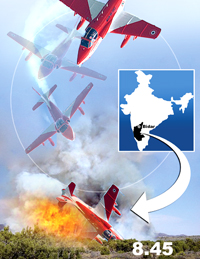INDIAN ARMED FORCES CHIEFS ON OUR RELENTLESS AND FOCUSED PUBLISHING EFFORTS

The insightful articles, inspiring narrations and analytical perspectives presented by the Editorial Team, establish an alluring connect with the reader. My compliments and best wishes to SP Guide Publications.

"Over the past 60 years, the growth of SP Guide Publications has mirrored the rising stature of Indian Navy. Its well-researched and informative magazines on Defence and Aerospace sector have served to shape an educated opinion of our military personnel, policy makers and the public alike. I wish SP's Publication team continued success, fair winds and following seas in all future endeavour!"

Since, its inception in 1964, SP Guide Publications has consistently demonstrated commitment to high-quality journalism in the aerospace and defence sectors, earning a well-deserved reputation as Asia's largest media house in this domain. I wish SP Guide Publications continued success in its pursuit of excellence.
- A leap in Indian aviation: Prime Minister Modi inaugurates Safran's Global MRO Hub in Hyderabad, Calls It a Milestone
- All about HAMMER Smart Precision Guided Weapon in India — “BEL-Safran Collaboration”
- India, Germany deepen defence ties as High Defence Committee charts ambitious plan
- True strategic autonomy will come only when our code is as indigenous as our hardware: Rajnath Singh
- EXCLUSIVE: Manish Kumar Jha speaks with Air Marshal Ashutosh Dixit, Chief of Integrated Defence Staff (CISC) at Headquarters, Integrated Defence Staff (IDS)
- Experts Speak: G20 Summit: A Sign of Global Fracture
Kiran Crash Claims Pilot

NEWS
An IAF fighter pilot from the acclaimed Surya Kiran Aerobatics Team (SKAT) was killed when a Kiran trainer aircraft crashed during a training sortie on Wednesday, January 21. Wing Commander R.S. Dhaliwal had joined the SKAT recently and was on the indigenous Kiran Mk II (HJT-16) trainer aircraft in a routine sortie, when the accident occurred at 8.45 am, IAF sources said. The aircraft, which took off from Bidar, crashed a few minutes later at a vacant plot near the air force station, but no loss of civilian life or property was reported in the incident, the sources said. The Air Headquarters immediately ordered a court of inquiry into the mishap.
VIEWS
Surya Kiran, the prestigious nine-aircraft aerobatic team, is the pride of the Indian Air Force (IAF). Institutionalised in 1996, the team has performed in practically every part of the country and also at major air shows in different parts of the world. It is now counted among the leading formation aerobatic teams in the world.
Equipped with Kiran Mark II (HJT-16) built by the Hindustan Aeronautics Limited (HAL), SKAT replaced the Thunderbolts, the first nine-aircraft formation aerobatic team of the IAF equipped with a much more powerful and versatile Hawker Hunter, a legendary combat aircraft of British origin and highly rated by fighter pilots the world over. Raised in the early 1980s, the Thunderbolts were patterned on the lines of the Red Arrows of the Royal Air Force. What is probably not widely known is that the initial experiment at formation aerobatics with the Kiran Mark I was undertaken by the Flying Instructors’ School (FIS) of the IAF at Tambaram by way of creation of a three-aircraft aerobatic team, christened Silver Streak. The name was attributable to the unpainted shining and silvery appearance of the Kiran Mark I aircraft sported.
Silver Streak comprised experienced Qualified Flying Instructors posted at FIS. This team put up a relatively simple profile as equipped with the Viper, a comparatively low-powered engine, the manoeuvre envelope of the Kiran Mark I was per force limited. Following news of the four aircraft formation aerobatic team of the USAF, the Thunderbirds going into the ground while practicing over the deserts of Arizona in 1982, Silver Streak was hurriedly disbanded. However, with the arrival of the Kiran Mark II equipped with a more powerful Orpheus engine, the Surya Kiran was constituted and based at Air Force Station Hakimpet near Hyderabad. Surya Kirans took over from the Thunderbolts as the Hunter aircraft was being phased out and was later relocated at Air Force Station Bidar. SKAT has now been assigned the status of an Air Force Squadron, No. 52 to be precise, and has a defined operational role as well.
Shocking as it is, the fatal accident at Bidar on January 21 comes at a time when the SKAT was busy gearing up for the forthcoming Aero India 2009. Contrary to media reports, the pilot involved was quite proficient and not newly inducted. Loss of one of the most experienced members of the team could lead to some difficulties for the team vis-à-vis the forthcoming event at Yelahanka. Incidentally, in the last three years, this is the second mishap with SKAT. In March 2006, two experienced pilots were killed in a flying accident at Bidar during a practice aerobatic sequence by the team.





